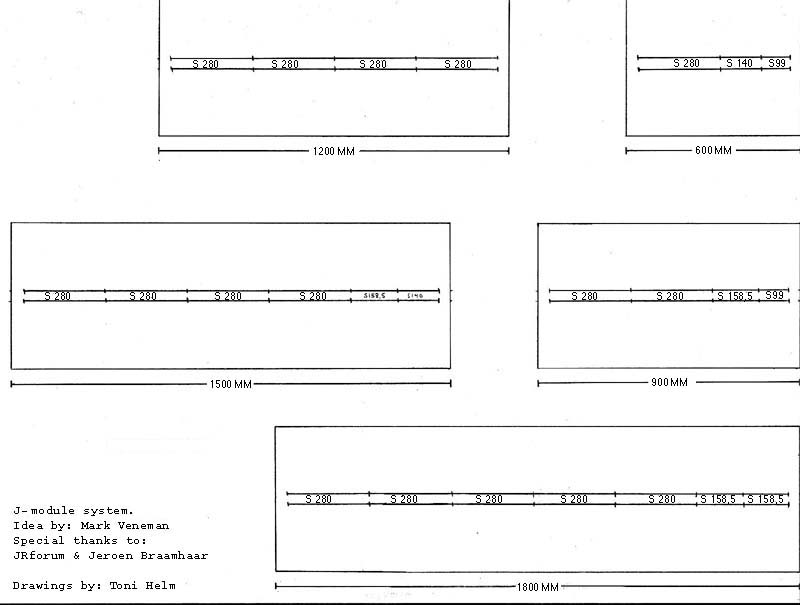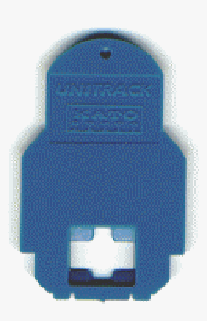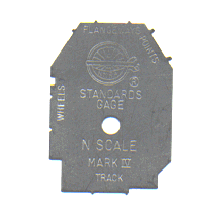 J-Module
J-Module J-Module
J-Module
J-Module is a new modular model railway system, developed especially for Japanese-outline N-scale model trains. The basics are really simple and all module sizes suit the use of Tomix sectional track.
Basically, J-Module does not differ very much from the popular North American NTrak standard, but the J-Module project team decided that it was better to do a few things different. Firstly, we decided to make it possible to use Tomix sectional track, although this is not compulsary. Secondly, we moved the tracks from the side to the centre of the module, so enabling the modules to be 'flipped' in set-ups at shows. This also sets no special need for 'inner' and 'outer' curve modules, only one curve or corner module will do, but we agreed on two different radii for variation. Both corner modules are built on the same framework. The modules connect with Tomix extendable track pieces, that are easy to fit. J-Module railtop level is at 1100 mm above floor level. This is a nominal value, as modules should have adjustable feet to compensate for uneven floors.

Basic straight J-Module configurations, note the different lengths. All modules are 500mm wide.
J-Modules can come in five different lengths, the shortest is 600mm, the longest is 1800mm, in 300mmintervals. Curves are a square of 760 x 760 mm, with the inner and outer corner 'chopped off' where desired. The electric system is simple and not very different from that used with NTrak, but as modules can be 'flipped' in a set-up, the wiring needs to be fully symmetrical and different, simple plugs and sockets are used.
Simple and cheap DIN loudspeaker connectors should be used to make the electrical connections. These are available in both solder and screw connector varieties. Available at electronic parts shops. The right-hand rail in the direction of travel should be connected to the round pin of the plug, preferred wire colour is red, the left-hand rail should be connected to the flat pin of the connector, preferred wire colour is black. Plugs should point in the normal direction of travel, keep in mind that in Japan the trains keep left, just as normal motor traffic does (similar to the UK, Australia, New Zealand etc.)
For the loading gauge, the imaginary tunnel in which a train should fit, there is a handy tool available from Kato, this gauge is included with the Kato rerailer and is useful for positioning platforms, catenary supports, signals etc. Use this tool only on straight sections, as the loading gauge becomes wider at curves, due to overhang of long vehicles, the tighter the curve, the larger the overhang!


Kato gauge for checking loading gauge, platform height and
catenary mast registration arm height and position (left) . NMRA
gauge for checking US-loading gauge, rail and wheel standards and
platform height (right).
This gauge may also be used for positioning catenary wire, although the manufacturers of model railway catenary (working!) have more suitable gauges in their ranges. The gauge on the right is the NMRA standards gauge, for checking loading gauge, platform height and rail and wheel standards. This gauge is wider than the Japanese Kato gauge, as it is made for modellers who model US-outline to 1:160 scale. US railways have a far wider loading gauge than Japanese railways (except Shinkansen lines), so the loading gauge of a model will be wider as well.
For those with interest to join the J-Module project I put the
standards on the web in the J-Module
Standards book.
More information? Interested? Join the J-Module discussion group. Apply at Yahoo Groups.
Text & scans by Mark Veneman
Drawings & logo design by Toni Helm
 Modelling
Modelling
 Layouts
Layouts
 Modeller's
Corner
Modeller's
Corner  Train
Simulators
Train
Simulators  Various
Various